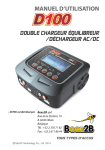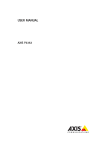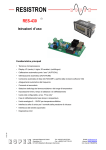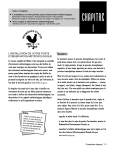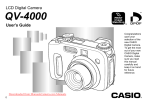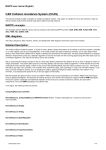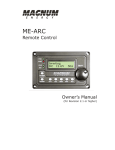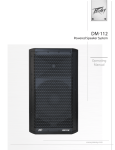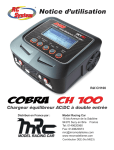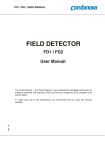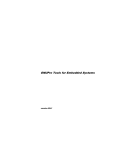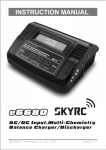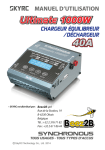Download WARNING: THE CHARGING AND DISCHARGING OF RC
Transcript
OPERATION MANUAL WARNING: THE CHARGING AND DISCHARGING OF RC HOBBY BATTERIES CAN BE DANGEROUS. FAILURE TO FOLLOW THE INSTRUCTIONS AND WARNINGS IN THIS MANUAL MAY RESULT IN PROPERTY DAMAGE AND/OR LOSS OF LIFE. Table of Contents Introduction Table of Contents: Congratulations on purchasing your new X2 AC Pro Charger! This latest addition to our innovative charger line offers expanded capacity and compatibility in a portable and compact package. With dual inputs affording flexible battery charging at home and in the field, the X2 AC Pro also boasts Hitec’s innovative power distribution mode which allows you to efficiently assign output power based on individual battery requirements. Capable of charging all battery chemistries (including the new generation LiHV), this powerhouse has a builtin 10-amp power supply, internal balancing circuits and 10 different charge/ discharge profiles. In addition, you may utilize your smartphone for remote control via our optional WiFi module. Introduction..................................................................................................................................03 Warning and Safety Notes.....................................................................................................04 Product Layout............................................................................................................................08 Specifications................................................................................................................................09 Features..........................................................................................................................................10 Battery & Power Supply Connections..............................................................................12 Power Distribution....................................................................................................................13 Operation.......................................................................................................................................14 Program Flow Chart..................................................................................................................15 Charger Operation....................................................................................................................16 Lithium Battery Program [LiP0/LiHV/LiFe/Lilon]..................................................................17 NiMh/NiCd Battery Program.................................................................................................25 Pb Lead-Acid Battery Program............................................................................................29 Battery Meter...............................................................................................................................32 Battery Resistance Meter........................................................................................................33 As with all Hitec products, please read the OPERATING INSTRUCTIONS, WARNING and SAFETY NOTES in their entirety before you attempt to use your new product. THE CHARGING AND DISCHARGING OF RC HOBBY BATTERIES CAN BE DANGEROUS. FAILURE TO FOLLOW THESE EXPLICIT WARNINGS CAN Warning RESULT IN PROPERTY DAMAGE AND/OR LOSS OF LIFE. A A A A NEVER LEAVE YOUR CHARGER UNATTENDED WHILE IN OPERATION. A IT IS HIGHLY RECOMMENDED THAT YOU UTILIZE A SAFETY DEVICE SUCH AS A STEEL CASE OR LIPO SACK™ WHILE CHARGING LITHIUM CHEMISTRY BATTERIES. A IT IS HIGHLY RECOMMENDED THAT YOU KEEP AN OPERABLE “CLASS A” FIRE EXTINGUISHER IN THE CHARGING AREA. Soldering Iron..............................................................................................................................34 Memory Preset - Data Store/Load......................................................................................36 Advanced System Set Up........................................................................................................38 Warning and Error Messages................................................................................................40 Using the Charge Control Software [CHARGE MASTER]...................................................41 NEVER CHARGE ON OR AROUND COMBUSTIBLE MATERIALS. NEVER CHARGE A DAMAGED BATTERY PACK. LOW COST, NO-NAME BATTERY PACKS POSE THE MOST DANGER. WE RECOMMEND YOU ONLY USE BATTERY PACKS THAT ARE SOLD AND WARRANTIED BY A REPUTABLE COMPANY. Recommended Accessory.......................................................................................................41 Commonly Used Terms............................................................................................................42 Conformity Declarations........................................................................................................43 Disposal and Prop 65 Warning............................................................................................44 Warranty and Service...............................................................................................................44 2 Warning FAILURE TO FOLLOW THESE WARNINGS CAN BE CONSIDERED NEGLIGENCE BY THE OPERATOR AND MAY NEGATE ANY CLAIMS FOR DAMAGES INCURRED. Hitec RCD USA will not be held responsible for any damages or injuries that may occur by persons who fail to follow these warnings or who fail to properly follow the instructions in this manual. 3 Warning and Safety Notes Warning: Be sure to read this section for your own safety. Warning Tip Caution: Be sure to read this section to prevent accidents and damage to your charger. Tip: This section will help you maximize the performance of your charger. Note Caution Warning and Safety Notes [cont.] A Never attempt to charge or discharge the following types of batteries: • A battery fitted with an integral charge circuit or a protection circuit • A battery pack which consists of different types of cells (including different manufacturer’s cells) Note: This section will provide more detailed explanations. These warnings and safety notes are of the utmost importance. You must follow these instructions for maximum safety. Failure to do so can damage the charger and the battery and in the worst cases, may cause a fire. NEVER LEAVE THE CHARGER UNATTENDED WHILE IT IS CONNECTED TO ITS POWER SOURCE. IF ANY MALFUNCTION IS FOUND, TERMINATE THE Warning PROCESS AT ONCE AND REFER TO THE OPERATION MANUAL. 4 A A A The allowable DC input voltage is 11-18V DC. A If the charger is dropped or suffers any type of impact, it should be inspected by an authorized service station before using it again. A This charger and the battery should be put on a heat-resistant, nonflammable and non-conductive surface. A Never place a charger on a car seat, carpet or similar surface. Keep all flammable volatile materials away from the operating area. A Make sure you know the specifications of the battery to be charged or discharged to ensure it meets the requirements of this charger. If the program is set up incorrectly, the battery and charger can be damaged. A A Fire or explosion can occur due to overcharging. The allowable AC input voltage is 100-240V AC. Keep the charger away from dust, damp, rain, heat, direct sunlight and excessive vibration. • A battery that is already fully charged or just slightly discharged and non-rechargeable batteries (these pose an explosion hazard) • • A faulty or damaged battery • Batteries that are not expressly stated by the manufacturer to be suitable for the currents the charger delivers during the charge process Batteries installed in a device or which are electrically linked to other components PLEASE BEAR IN MIND THE FOLLOWING POINTS BEFORE YOU COMMENCE CHARGING: • Did you select the appropriate program suitable for the type of battery you are charging? • • Did you set up the adequate current for charging or discharging? • • Have you checked that all connections are firm and secure? Have you checked the battery voltage? Lithium battery packs can be wired in parallel and in series, i.e. a 2-cell pack can be 3.7V (in parallel) or 7.4V (in series). Make sure there are no intermittent contacts at any point in the circuit. To avoid a short circuit between the charge lead, always connect the charge cable to the charger first, then connect the battery. Reverse the sequence when disconnecting. 5 Warning and Safety Notes [cont.] Warning and Safety Notes [cont.] Standard Battery Parameters LiPo 3.7V/cell LiPo HV 3.7V/cell LiIon 3.6V/cell LiFe 3.3V/cell NiCd 1.2V/cell NiMH 1.2V/cell Pb 2.0V/cell Max. Charge Voltage 4.2V/cell 4.35V/cell 4.1V/cell 3.6V/cell 1.5V/cell 1.5V/cell 2.46V/cell Storage Voltage 3.8V/cell 3.85V/cell 3.7V/cell 3.3V/cell n/a n/a n/a ≤ 1C ≤ 1C ≤ 1C ≤ 4C ≤ 1-2C ≤ 1-2C ≤ .04C 0.1-1.1V/cell 1.8V/cell Nominal Voltage Allowable Fast Charge Min. Discharge Voltage 3.0-3.3V/cell 3.1-3.4V/cell 2.9-3.2V/cell 2.6-2.9V/cell 0.1-1.1V/cell WHEN ADJUSTING YOUR X2 AC PRO CHARGING PARAMETERS, BE SURE YOU SELECT THE PROPER BATTERY TYPE AND CELL VOLTAGE FOR THE TYPE Warning OF CELL YOU ARE CHARGING. CHARGING BATTERIES WITH THE WRONG SETTINGS MAY CAUSE THE CELLS TO BURST, CATCH FIRE OR EXPLODE. Charging Before charging your batteries, it is critical that you determine the maximum allowable charge rate for your batteries. The X2 AC Pro is capable of charging at high rates that may not be suitable or safe for your particular batteries. For example, Lithium cells are typically safe to charge at 1C, or the total mAh÷1000. A 1200mAh battery would have a 1C charge rate of 1.2 amps. A 4200mAh battery would have a 1C charge rate of 4.2 amps. Some manufacturers are offering Lithium cells that can be charged at greater than 1C but this should ALWAYS be verified before charging a Lithium battery at rates higher than 1C. Voltage is just as critical as the charging amperage rate and this is determined by the number of cells in series, or “S”. For example, a 3S LiPo is rated at 11.1 volts (“S” multiplied by a single LiPo cell with a nominal voltage of 3.7 volts DC. 3 cells x 3.7 volts each equals 11.1 volts DC). Connect the battery’s main leads to the charger output: red is positive and black is negative. Keep in mind that the gauge or thickness of your charging leads from the X2 AC Pro to your battery must be of an acceptable current rating to handle the applied charge current. For maximum safety and charging effectiveness, always match or exceed the main battery lead rating when assembling or selecting your charging leads. If you charge a battery at a high current rate (amperage) with a charging lead not rated for the chosen amperage, the wire could get hot, catch fire, short out and/or potentially destroy your battery and the charger. 6 When in doubt, always use a higher gauge wire (lower AWG number). It is common to see charging leads constructed of 14AWG, 16AWG or 18AWG wire. Always refer to recommendations from your battery manufacturer for your specific battery type and size before initiating a charge or discharge process. Do not attempt to disassemble or modify Lithium or Lead-Acid battery packs. Discharging The X2 AC Pro discharging functions are for two specific purposes: • Refreshing the capacity of a Nickel-based battery that has lost capacity over time (NiMH or NiCd). • Reducing the voltage of a Lithium battery for safe storage. Note LITHIUM CHEMISTRY BATTERY PACKS SHOULD ONLY BE DISCHARGED TO THEIR MINIMUM SAFE VOLTAGE, NO LOWER. DEEP DISCHARGING A LITHIUM CELL WILL DO PERMANENT DAMAGE. REFER TO THE STANDARD BATTERY PARAMETERS TABLE ON PAGE 6 OF THIS MANUAL FOR MINIMUM DISCHARGE VOLTAGES. LiPo & LiHV Charge/Discharge Cycling Lithium batteries are known to reach full capacity after a break-in period of about 10 charge/discharge cycles. We do not recommend you use the X2 AC Pro charger to do this; normal use and recharging will achieve the same results. If you wish to perform a Lithium break-in on the bench with the X2 AC Pro, discharging to minimum acceptable voltages and performing a balance charge at 1C maximum rate is recommended. If you choose to break in your Lithium batteries under normal use, charging at only 1C for the first ten cycles will help ensure full performance and service life from your Lithium cells. 7 Product Layout Specifications In the case of an error, the screen will communicate the cause of the error and emit an audible sound. X2 AC Pro Specifications AC Input 100 - 240V AC The Set Contains: DC Input 11 - 20V DC 1. X2 AC Pro Charger 2. XH Adaptor X 2 3. Power Cord 4. Charging Cable X 2 5. Banana Connectors with XT60 Connector Charging Cable X 2 6. Soldering Iron Handle 7. Soldering Tip (Pencil Tip) 8. Soldering Tip (Chisel Tip) 9. Soldering Iron Stand 10. Cleaning Sponge Total Charge Circuit Power CH A 200W / CH B 100W DC input Charge Current Range CH A 0.1-20A / CH B 0.1-10A Discharge Current Range 10W x 2 Discharge Current Power 0.1 - 5.0A x 2 Current Drain for LiPo Balancing 200mA per cell NiCd/NiMH Battery Cell Count 1 - 15 Cells - Capacity Range 100 - 50,000mAh LiPo/LiHV/LiFe/Lilon Cell Count 1 - 6 Cells - Capacity Range 100 - 50,000mAh Pb Battery Voltage 2 - 20 V - Capacity Range 100 - 50,000mAh Net Weight Dimensions Soldering Iron 8 200W AC input (Support Power Distribution) 2.78 lbs 1260g 7.76 x 7.17 x 2.80in 197 x 182 x 71mm 60W Max 392°F - 842°F 60W Max 200°C - 450°C 9 Features Features [cont.] Dual Input and Power Distribution: Re-Peak Mode of NiMH/NiCd Battery: The X2 AC Pro has a dual AC/DC input comprised of AC 100-240V and DC 11-18V. In DC mode, the power of each channel is 100W with an overall power of 200W. Power distribution is supported in AC mode. For example, if Channel A is 70W and Channel B is 30W, total power is 100W. Delta-Peak Sensitivity for NiMH/NiCd: Optimized Operating Software: The X2 AC Pro features an AUTO function that sets the feeding current during charging or discharging. For lithium batteries especially, this function helps prevent overcharging and its consequences. It can also disconnect the circuit automatically and sound an alarm if an abnormal reaction has been detected. Each programming feature of your X2 AC Pro is controlled by two way linkage and communication and is completely customizable to the user’s preferences. Battery Memory (Data Store/Load): In re-peak charge mode, the charger can peak charge the battery once, twice, or three times in a row automatically. This function is useful for ensuring a full battery charge. This automatic charge termination program is based on the principle of the Delta-peak voltage detection. When the battery’s voltage exceeds the threshold, the process will be terminated automatically. Cyclic Charging/Discharging: 1 to 5 cyclic and continuous charge > discharge or discharge > charge sessions are optimal for battery performance and balancing. Automatic Charging Current Limit: The charger can store up to 10 unique charge/discharge profiles for each channel and lets you recall the data from each program setting at any time. You can set the upper limit of the charging current when charging your NiMH or NiCd battery. The ‘AUTO’ charging mode, however, is recommended when charging NiMH batteries with low impedance and capacity. Terminal Voltage Control(TVC): LiPo Battery Meter: For experienced users, the charger’s end voltage can be reset. PC Control Software “Charge Master”: Equipped with free “Charge Master” software, the X2 AC Pro gives you unparalleled ability to operate the charger via your personal computer. You can monitor pack voltage, cell voltage, and other data during battery charging or view the charge data in real-time graphs. The “Charge Master” gives you the option to initiate and update firmware as well. The user can check the battery’s total voltage, the highest voltage, the lowest voltage and the voltage of each cell. Battery Internal Resistance Meter: The user can check the battery’s total internal resistance and the internal resistance of each cell. Capacity Limit: With the “Charger Master” software and a single computer connection, you are able to operate and update two channels at the same time. The charging capacity is always calculated as the charging current multiplied by time. If the charging capacity exceeds the limit, the process will automatically terminate according to the maximum value previously set. Smart Phone Control via Wi-Fi Module (iOS and Android): Temperature Threshold*: Finally, a battery charger with its own apps! This charger can be operated using a smart phone with Wi-Fi connectivity (optional part 44228). The battery’s internal chemical reaction will cause the temperature of the battery to rise. If the temperature limit is reached, the process will be terminated. Internal Independent Lithium Battery Balancer: * This function is available by connecting an optional temperature probe which is available as a separate purchase. Hitec’s X2 AC Pro employs an individual cell-voltage balancer. It is not necessary to connect an external balancer for balance charging. Processing Time Limit: Protect your battery by setting a maximum time limit for charging and discharging. 10 11 Battery & Power Supply Connections Power Distribution Channel B TO AVOID SHORT CIRCUITS, ALWAYS CONNECT THE CHARGE LEADS TO THE CHARGER FIRST, AND THEN TO THE BATTERY. REVERSE THE Warning SEQUENCE WHEN DISCONNECTING THE PACK. X1 CHARGER Battery Connection With Balance Adaptor. 2S 3S 4S 5S 6S 1 2 3 4 5 6 A Channel A BALANCE LEAD BALANCE SOCKET Channel A DC 11-18V BATTERY Battery Connection Without Balance Adaptor. Channel B X1 CHARGER BATTERY 12VDC Battery/DC Power Supply Connection. DC 11-18V * 12 B BATT/PROGRAM SYSTEM SETTING-> LIPO BALANCE 5.1A 22.2V(6S) A B Safety Timer ON 120Min LIPO BALANCE 5.1A 22.2V(6S) BALANCE ADAPTOR BALANCE SOCKET DC 11-18V A BALANCE SOCKET B AC Max Power Set 70W AC Max Power Set 30W A B AC Max Power Set 50W LIPO BALANCE 5.1A 22.2V(6S) Powered by AC Household Current: In AC mode the X2 AC Pro has a maximum charging output of 100 watts total. This charge output can be allocated differently to each channel utilizing the Power Distribution feature. To adjust the wattage between channel got to BATT/PROGRAM menu and use the INC. – or DEC + buttons to get to the SYSTEM SETTINGS, press ENTER/Start to enter the System settings menu and use the – or + buttons to scroll to the AC Max Power Set screen. Press ENTER/Start and the wattage amount will begin to blink. Use the – or + buttons to adjust the wattage for that channel. Note Adjusting one channel will change the other channel proportionally. i.e you change one channel to 70 watts the other channel will only have 30 watts available for charging. Powered by Automotive Battery or DC Power Supply: In DC mode the X2 AC Pro has a maximum charging output of 200 watts total. This is allocated a 100 watts per channel and cannot be adjusted. It is extremely important that you use either a fully charged 13.8V car battery or a high quality AC/DC power supply in the range of 11-18V DC output with minimum power of 240W or higher to ensure a reliable performance. * 12VDC battery or 11~18V DC, 30 amp power supply 13 Operation Program Flow Chart Note Switch from Channel A to B or Channel B to A Scroll Through the Main Menu Stop Any Charge Processes The flow chart depicts one channel as the example for both channels. Channel A and Channel B are identical. A and Resume or Start Charge Processes Confirm Any Action Channel B) are identical. INC DEC START LiPo BALANCE CHG INC LiPo CHARGE BATT/PROGRAM 7.4V (2S) LiPo BATT ENTER 2.0A 7.4V (2S) DEC 2.0A INC DEC LiPo FAST CHARGE 2.0A 7.4V (2S) Alter Values See the Status of Individual Cells in Balance Charge Mode CH A/CH B: Switch from Channel A to B or from Channel B to A. BATT PROG / STOP Button: Stop a function in- progress or to go back to previous step/screen. DEC Button: Scroll through menus or decrease the parameter value. INC Button: Scroll through the menus or increase the parameter value. ENTER / START Button: Enter parameters or store parameters on-screen. When changing a parameter value in the program, press the START/ENTER button to make it blink, then change the value by pressing the DEC and INC button. The value will be stored by repressing the START/ENTER button. If there is a second parameter to edit on the same screen, it will begin blinking after you confirm the first parameter value. When you power the charger on, it will automatically enter the LiPo Battery balance program screen. You can change the mode (balance mode, normal charge mode, fast charge mode, store mode, or discharge mode), enter the desired charging/discharging mode, or set the preferred parameter to begin. If there are no changes to make in the LiPo Battery program, press the BATT PROG/ STOP button to enter the BATT PROGRAM screen. START LiFe BALANCE CHG BATT/PROGRAM LiFe BATT ENTER 2.0A 6.6V (2S) INC LiPo DISCHARGE LiPo STORAGE 2.0A 7.4V (2S) DEC 2.0A 7.4V (2S) INC LiFe CHARGE INC LiFe FAST CHARGE DEC 2.0A 6.6V (2S) LiFe STORAGE DEC 2.0A 6.6V (2S) DEC 2.0A INC Lilo CHARGE INC INC INC Lilo DISCHARGE DEC 2.0A 6.6V (2S) INC INC LiFe DISCHARGE 6.6V (2S) INC DEC START Lilo BALANCE CHG BATT/PROGRAM LiIo BATT ENTER 2.0A 7.2V (2S) DEC 2.0A Lilo FAST CHARGE DEC 2.0A 7.2V (2S) 7.2V (2S) Lilo STORAGE DEC 2.0A 7.2V (2S) DEC 2.0A LiHV FAST CHARGE INC LiHV STORAGE 2.0A 7.6V (2S) DEC 2.0A 7.6V (2S) DEC 2.0A 7.2V (2S) INC DEC START LiHV BALANCE CHG INC LiHV CHARGE BATT/PROGRAM LiHV BATT ENTER 2.0A 7.6V (2S) DEC 2.0A 7.6V (2S) INC DEC INC LiHV DISCHARGE 7.6V (2S) INC DEC START NiMH CHARGE BATT/PROGRAM NiMH BATT ENTER CURRENT 2.0A INC NiMH A INC INC NiMH DISCHARGE CUT: 1.0V DEC NiCd DISCHARGE CUT: 1.0V DEC O C O INC Te C 000 AH DEC ON 0 C 122 F DEC o CHARGE 2.0A DEC 0.1A o CHARGE 2.0A DEC 0.1A DEC CURRENT NiMH RE PEA INC 1 DEC 1 DEC NiMH CYCLE CHG>DCHG 1 NiCd CYCLE CHG>DCHG 1 INC DEC START NiCd CHARGE BATT/PROGRAM NiCd BATT ENTER CURRENT 2.0A INC NiCd A INC DEC CURRENT INC NiCd RE PEA INC INC DEC START Pb CHARGE BATT/PROGRAM Pb BATT ENTER 2.0A 2.0V (1P) INC Pb DISCHARGE DEC 0.1A 2.0V (1P) INC DEC START 4.20 4.19 4.19 V BATT/PROGRAM BATT METER ENTER 0.00 0.00 0.00 V INC DEC MAIN 0.00V H0.000V L0.000V INC DEC START 00 00 00 Ω INC START S e Ti e BATT/PROGRAM 120Mi SYSTEM SETTING > ENTER ON DEC BATT/PROGRAM BATT RESISTANCE INC Ω DEC ENTER 00 TATAL: 16 Ω H: Ω L: Ω DEC INC C ON i INC Te e Re Ti e e U INC i Cel i DEC CHG>DCHG 10Mi INC DEC NiMH Se i i i D.Pe De l INC DEC INC DEC S o B BATT/PROGRAM BATT MEMORY T Ve INC io e H :1.00 F : 1.10 START ENTER Lo d F DEC Se INC AC M e DEC o E INC BATT MEMORY 1 START BATT TYPE ENTER SET > ENTER LiPo DEC Po e Se 0 INC DEC DC I Lo CUT OFF 11.0V INC DEC B e Bee e ON NO INC CHARGE CURRENT INC DSCH CURRENT BATT VOLTS 7.4V ( 2S ) DEC 4.9A DEC 2.2A INC DEC INC DEC NiCd D.Pe Se i i i De l DSCH VOLTAGE .0V/CELL INC DEC STARG/ENTER> Se o d ENTER CHARGER LOAD ENTER START BATT MEMORY 1 LiPo 7.4V (2S ) BATT MEMORY 1 C:4.9A D:2.2A LiPo BALANCE CHG INC LiPo CHARGE 4.9A 7.4V(2S) DEC 4.9A 7.4V(2S) INC BATT MEMORY 2 START BATT TYPE ENTER SET > ENTER MiMH DEC SAVE PROGRAM SAVE . INC DEC INC START SAVE PROGRAM ENTER LiPo FAST CHARGE INC 4.9A 7.4V(2S) DEC ENTER DEC LiPo STORAGE 4.9A 7.4V(2S) INC CHARGE CURRENT INC TRIC LE BATT VOLTS 2.4V (2S) DEC . A DEC 100 A INC DEC INC TVC YOUR RIS 4.20V LiPo DISCHARGE 2.2A 7.4V(2S) PEA DELAY START START SAVE PROGRAM SAVE . ENTER DEC INC DSCH CURRENT DSCH VOLTAGE ENTER DEC 1.1V/CELL DEC 2.2A START SAVE PROGRAM INC ENTER > ENTER CHARGER LOAD ENTER BATT MEMORY 2 NiMH 2.4V (2S ) 1Mi DEC INC BATT MEMORY 2 C:1.0A D:1.0A INC NiMH A o CHARG NiMH CHARGE E CURRENT 1.0A DEC CURRENT 1.2A INC START BATT TYPE BATT MEMORY Pb ENTER SET > ENTER Pb CHARGE . A 4.0V(2P) DEC ENTER CHARGER LOAD BATT VOLTS 4.0V (2P) BATT MEMORY C: . A D:1. A STARG/ENTER> Pb DISCHARGE 1. A 4.0V(2P) 14 INC DEC INC DEC INC DEC INC DEC NiMH DISCHARGE 1.0A CUT: 2.0V INC NiMH RE PEA DEC INC 2 DEC NiMH CYCLE DCHG>CHG 1 INC DSCH VOLTAGE CHARGE CURRENT INC DSCH CURRENT . A DEC 1. A DEC 1.7V/CELL BATT MEMORY Pb 4.0V (2S ) SAVE PROGRAM SAVE . INC DEC START SAVE PROGRAM ENTER ENTER For larger version visit www.hitecrcd.com 15 Charger Operation Lithium Battery Program [LiP0/LiHV/LiFe/Lilon] The following section contains detailed procedures that must be followed to make the charger work. When you power the charger on, it will automatically enter the LiPo Battery balance program screen. Use the CHA/CHB button to toggle between channels A and B and the BATT PROG/STOP button to enter the BATT PROGRAM screen. Once in the Battery Programming section use the < or > to select the desire battery or function then press ENTER/Start to make your parameter adjustments. The X2 AC Pro is capable of the following processes based on the type of battery chosen. Lithium: Batt Type LiPo Lilon LiFe LiHV Operation Program Pb 16 The X2 AC Pro offers the following lithium charge modes: Charge, Balance Charge, Fast Charge, Storage and Discharge. BEFORE SELECTING A CHARGE MODE, IT IS CRITICAL THAT YOU SELECT THE CORRECT TYPE OF LITHIUM BATTERY TO BE CHARGED. FAILURE TO DO SO Warning CAN RESULT IN DAMAGE TO THE BATTERY AND POSSIBLE EXPLOSION. CHARGE This charging mode is for charging LiPo/LiFe/LiIon/LiHV battery in normal mode. DISCHARGE This mode is for discharging LiPo/LiFe/LiIon/LiHV battery. STORAGE This program is for charging or discharging lithium battery which will not be used for long time. Selecting a Lithium Battery Type: From the “BATT/PROGRAM” screen, press the INC. – or BATT/PROGRAM LiPo BATT DEC + button to scroll through the battery type selections. Once you have selected the correct battery type, press the ENTER/Start ► button to enter the charge/discharge menu. FAST CHG The charging capacity may be less than normal charging but the process time will be reduced. Lithium Charge Mode: BAL CHARGE This mode is for balancing the voltage of lithium-polymer battery cells while charging. CHARGE The charger will charge NiMH and NiCd batteries using the charge current set by the user. AUTO CHG NiMH NiCd Description This program is only suitable for charging/discharging Lithium chemistry batteries (LiPo, LiHV, LiIon and LiFe). In this program the charger detects the condition of the battery which is connected to the output and automatically charges the battery. Note: You should set up the upper limit of the charge current to avoid damage by excessive feeding current. Some batteries of low resistance and capacity can lead to higher current. DISCHARGE This mode is for discharging NiMH/NiCd battery. RE-PEAK In re-peak charge mode, the charger can peak charge the battery once, twice or three times in a row automatically. This is good for confirming the battery is fully charged, and for checking how well the battery receives fast charges. CYCLE 1 to 5 cyclic and continuous process of charge>discharge or discharge>charge is operable for battery refreshing and balancing to stimulate the battery's activity. CHARGE This mode is for charging Pb battery. DISCHARGE This mode is for discharging Pb battery. BEFORE YOU BEGIN CHARGING YOUR BATTERY, MAKE SURE YOU HAVE READ AND UNDERSTAND ALL OF THE WARNINGS AND SAFETY Warning INFORMATION CONTAINED ON PAGES 02-07. Note IN THE CHARGE MODE, LITHIUM BATTERIES CAN BE CHARGED WITHOUT THE USE OF A BALANCE ADAPTOR. A BALANCE ADAPTOR CAN BE USED, BUT IT IS NOT REQUIRED. BALANCE CHARGE MODE IS RECOMMENDED FOR ANY BATTERY WITH A BALANCE LEAD. See page 12 for the appropriate charging connections setup for this operation. First, select the correct battery type by following the instructions page 16. Once you have set the correct battery type, press the ► button once to enter the charge mode and battery settings screen, use the INC. – or DEC + to select “CHARGE” mode. Press the ► button again and the amp rate value will begin flashing. Use the + or ▬ buttons to adjust the value to the desired rate. Follow the instructions provided with your battery when setting the charge amperage rate. Press the ► button again and the voltage value will begin flashing. Use the + or ▬ buttons to adjust the value to the desired rate. The voltage and cell count should match the values listed on the battery label. LiPo Charge 2.7A 11.1V (3S) 17 Lithium Battery Program [LiP0/LiHV/LiFe/Lilon cont.] Lithium Battery Program [LiP0/LiHV/LiFe/Lilon cont.] You are now ready to begin charging. Press and hold the ENTER/Start ► button until you see “BATTERY CHECK.” followed by the “CONFIRM (ENTER) / CANCEL(STOP)“ R:3SE R S:3SER CONFIRM(ENTER) screen. This screen displays the number of cells you set up as ”R” and the number of cells detected by the processor as “S”. If both numbers are identical, you may press and hold the ENTER/Start ► button to confirm and begin charging. If these numbers do not match, press the BATT/PROG Stop ■ button to return to the previous screen and carefully check the number of cells of the battery pack before proceeding. See page 12 for the appropriate charging connections setup for this operation. R:3SE R S:3SER CANCEL(STOP) DURING CHARGING/DISCHARGING, THE BATTERY SHOULD BE PLACED INSIDE A FIRE PROOF/RETARDANT BAG AND ON A FIRE PROOF SURFACE Caution AWAY FROM OTHER COMBUSTIBLE OBJECTS. Once charging has commenced, the charger will display the following real-time information: battery type/cell count, charging current, battery voltage, charging time and charged capacity. LP3s 2.7A 11.88V CHG 005:39 00256 If you are using a balance adaptor during charging, you may press the + button to view the voltage of each individual cell. You can also view a variety of other information as detailed on page 13. 4.07 4.06 4.11V 0.00 0.00 0.00V Once the battery is fully charged the screen will read “FINISHED” and the charger will emit a chiming sound. Press the ■ button to stop charging. You may also press the ■ button at any time during the charging process to stop charging. Lithium Balance Charge Mode: This function is for balancing the voltage of individual Lithium-polymer battery cells while charging. In order to use the Balance Mode, the battery must have a balance lead. Charging in this mode is different from the normal modes because the built-in processor monitors the voltage of each individual cell and controls the discharge of each individual cell in order to equalize the voltage. Use of a balance adaptor with any battery that has a balance lead will improve the performance and lifespan of your battery. BEFORE YOU BEGIN CHARGING YOUR BATTERY, MAKE SURE YOU HAVE READ AND UNDERSTAND ALL OF THE WARNINGS AND SAFETY Warning INFORMATION CONTAINED ON PAGES 02-07. 18 First, select the correct battery type by following the instructions on page 16. Once you have set the correct battery type, press the ► button once to enter the charge mode and battery settings screen, use the INC. – or DEC + to select “BALANCE” mode. Press the ► button again and the amp rate value will begin flashing. Use the + or ▬ buttons to adjust the value to the desired rate. Follow the instructions provided with your battery when setting the charge amperage rate. LiPo BALANCE 2.7A 11.1V (3S) Press the ► button again and the voltage value will begin flashing. Use the + or ▬ buttons to adjust the value to the desired rate. The voltage and cell count should match the values listed on the battery label. You are now ready to begin charging. Press and hold the ENTER/Start ► button until you see “BATTERY CHECK.” followed by the “CONFIRM (ENTER) / CANCEL(STOP)“ R:3SE R S:3SER CONFIRM(ENTER) screen. This screen displays the number of cells you set up as ”R” and the number of cells detected by the processor as “S”. If both numbers are identical, you may press and hold the ENTER/Start ► button to confirm and begin charging. If these numbers do not match, press the BATT/PROG Stop ■ button to return to the previous screen and carefully check the number of cells of the battery pack before proceeding. R:3SE R S:3SER CANCEL(STOP) DURING CHARGING/DISCHARGING, THE BATTERY SHOULD BE PLACED INSIDE A FIRE PROOF/RETARDANT BAG AND ON A FIRE PROOF SURFACE Caution AWAY FROM OTHER COMBUSTIBLE OBJECTS. Once charging has commenced, the charger will display the following real-time information: battery type/cell count, charging current, battery voltage, charging time and charged capacity. LP3s 2.7A 11.88V BAL 005:39 00256 To view the voltage of each individual cell charging, press the + button. You can also view a variety of other information as detailed on page 12. Once the battery is fully charged the screen will read “FINISHED” and the charger will emit a chiming sound. Press the ■ button to stop charging. You may also press the ■ button at any time during the charging process to stop charging. 4.07 4.06 4.11V 0.00 0.00 0.00V 19 Lithium Battery Program [LiP0/LiHV/LiFe/Lilon cont.] Lithium Fast Charge Mode: Charging in Fast Charge Mode allows for a shorter charge time and will result in a slightly reduced charging capacity. To achieve maximum charge capacity, we recommend you use the Lithium Balance Charge Mode. If a fast charge is necessary, select the fast charge mode and follow the same charging instructions as for the Lithium Charge Mode or Lithium Balance Charge Mode. BEFORE YOU BEGIN CHARGING YOUR BATTERY, MAKE SURE YOU HAVE READ AND UNDERSTAND ALL OF THE WARNINGS AND SAFETY Warning INFORMATION CONTAINED ON PAGES 02-07. Note IN THE CHARGE MODE, LITHIUM BATTERIES CAN BE CHARGED WITHOUT THE USE OF A BALANCE ADAPTOR. A BALANCE ADAPTOR CAN BE USED, BUT IT IS NOT REQUIRED. BALANCE CHARGE MODE IS RECOMMENDED FOR ANY BATTERY WITH A BALANCE LEAD. Lithium Battery Program [LiP0/LiHV/LiFe/Lilon cont.] DURING CHARGING/DISCHARGING, THE BATTERY SHOULD BE PLACED INSIDE A FIRE PROOF/RETARDANT BAG AND ON A FIRE PROOF SURFACE Caution AWAY FROM OTHER COMBUSTIBLE OBJECTS. Once charging has commenced, the charger will display the following real-time information: battery type/cell count, charging current, battery voltage, charging time and charged capacity. LP3s 2.7A 11.88V FAS 005:39 00256 If you are using a balance adaptor during charging, you may press the + button to view the voltage of each individual cell. You can also view a variety of other information as detailed on page 13. 4.07 4.06 4.11V 0.00 0.00 0.00V Once the battery is fully charged the screen will read “FINISHED” and the charger will emit a chiming sound. Press the ■ button to stop charging. You may also press the ■ button at any time during the charging process to stop charging. See page 12 for the appropriate charging connections setup for this operation. Lithium Storage Mode: First, select the correct battery type by following the instructions above. Once you have set the correct battery type, press the ► button once to enter the charge mode and battery settings screen, use the INC. – or DEC + to select “FAST CHG” mode. Press the ► button again and the amp rate value will begin flashing. Use the + or ▬ buttons to adjust the value to the desired rate. Follow the instructions provided with your battery when setting the charge amperage rate. This function is for charging/discharging batteries that will not be used immediately. The program is designed for charging/discharging batteries up-to or down-to safe storage levels. The program will automatically begin to discharge if the current state of the battery exceeds the voltage level for storage. 4.07 4.06 4.11V 0.00 0.00 0.00V Press the ► button again and the voltage value will begin flashing. Use the + or ▬ buttons to adjust the value to the desired rate. The voltage and cell count should match the values listed on the battery label. You are now ready to begin charging. Press and hold the ENTER/Start ► button until you see “BATTERY CHECK.” followed by the “CONFIRM (ENTER) / CANCEL(STOP)“ R:3SE R S:3SER CONFIRM(ENTER) screen. This screen displays the number of cells you set up as ”R” and the number of cells detected by the processor as “S”. If both numbers are identical, you may press and hold the ENTER/Start ► button to confirm and begin charging. If these numbers do not match, press the BATT/PROG Stop ■ button to return to the previous screen and carefully check the number of cells of the battery pack before proceeding. R:3SE R S:3SER CANCEL(STOP) 20 BEFORE YOU BEGIN CHARGING YOUR BATTERY, MAKE SURE YOU HAVE READ AND UNDERSTAND ALL OF THE WARNINGS AND SAFETY Warning INFORMATION CONTAINED ON PAGES 02-07. Note IN STORAGE MODE, LITHIUM BATTERIES CAN BE CHARGED WITHOUT THE USE OF A BALANCE ADAPTOR. A BALANCE ADAPTER CAN BE USED, BUT IT IS NOT REQUIRED. BALANCE CHARGE MODE IS RECOMMENDED FOR ANY BATTERY WITH A BALANCE LEAD. See page 12 for the appropriate charging connections setup for this operation. First, select the correct battery type by following the instructions above. Once you have set the correct battery type, press the ► button once to enter the charge mode and battery settings screen, use the INC. – or DEC + to select “STORAGE” mode. Press the ► button again and the amp rate value will begin flashing. Use the + or ▬ buttons to adjust the value to the desired rate. Follow the instructions provided with your battery when setting the charge amperage rate. LiPo STORAGE 2.7A 11.1V (3S) 21 Lithium Battery Program [LiP0/LiHV/LiFe/Lilon cont.] Lithium Battery Program [LiP0/LiHV/LiFe/Lilon cont.] Press the ► button again and the voltage value will begin flashing. Use the + or ▬ buttons to adjust the value to the desired rate. The voltage and cell count should match the values listed on the battery label. DISCHARGING LITHIUM CHEMISTRY BATTERIES CAN CAUSE PERMANENT DAMAGE TO THE BATTERY AND IT IS NOT RECOMMENDED FOR Warning ANYTHING OTHER THAN THE DISPOSAL OF THE BATTERY. IF YOU CHOOSE TO DISCHARGE YOUR LITHIUM BATTERIES, MAKE SURE TO PAY CLOSE ATTENTION TO THE MINIMUM VOLTAGE SETTING. IF YOU WANT TO STORE YOUR BATTERY FOR A LONG PERIOD OF TIME YOU SHOULD UTILIZE THE STORAGE MODE CHARGE PROGRAM AS THIS IS THE SAFEST METHOD OF STORING YOUR LITHIUM CHEMISTRY BATTERIES. You are now ready to begin charging. Press and hold the ENTER/Start ► button until you see “BATTERY CHECK.” followed by the “CONFIRM (ENTER) / CANCEL(STOP)“ R:3SE R S:3SER CONFIRM(ENTER) screen. This screen displays the number of cells you set up as ”R” and the number of cells detected by the processor as “S”. If both numbers are identical, you may press and hold the ENTER/Start ► button to confirm and begin charging. If these numbers do not match, press the BATT/PROG Stop ■ button to return to the previous screen and carefully check the number of cells of the battery pack before proceeding. R:3SE R S:3SER CANCEL(STOP) DURING CHARGING/DISCHARGING, THE BATTERY SHOULD BE PLACED INSIDE A FIRE PROOF/RETARDANT BAG AND ON A FIRE PROOF SURFACE Caution AWAY FROM OTHER COMBUSTIBLE OBJECTS. Once charging has commenced, the charger will display the following real-time information: battery type/cell count, charging current, battery voltage, charging time and charged capacity. LP3s 2.7A 11.88V STO 005:39 00256 If you are using a balance adaptor during charging, you may press the + button to view the voltage of each individual cell. You can also view a variety of other information as detailed on page 13. 4.07 4.06 4.11V 0.00 0.00 0.00V Once the battery has reached storage level the screen will read “STORAGE FINISHED” and the charger will emit a chiming sound. Press the ■ button to stop charging. You may also press the ■ button at any time during the charging process to stop charging. Lithium Discharge Mode: If you plan to discharge your battery to reach safe storage levels, we strongly recommend that you use Storage Mode. In very few instances should discharging become necessary with LiPo batteries. One such instance may include preparing a battery for disposal, in which case the battery should not be completely discharged. Be sure to follow the discharging instructions provided by the battery manufacturer. Over-discharging a battery can severely damage the battery and may cause a fire or explosion. 22 Note IN DISCHARGE MODE, LITHIUM BATTERIES CAN BE DISCHARGED WITH OR WITHOUT THE USE OF A BALANCE ADAPTOR. THE USE OF A BALANCE ADAPTOR IS RECOMMENDED FOR DISCHARGING ANY BATTERY THAT HAS A BALANCE LEAD. See page 12 for the appropriate charging connections setup for this operation. First, select the correct battery type by following the instructions above. Once you have set the correct battery type, press the ► button once to enter the charge mode and battery settings screen, use the INC. – or DEC + to select “DISCHARGE” mode. Press the ► button again and the amp rate value will begin flashing. Use the + or ▬ buttons to adjust the value to the desired rate. Follow the instructions provided with your battery when setting the charge amperage rate. LiPo DISCHARGE 2.7A 11.1V (3S) Press the ► button again and the voltage value will begin flashing. Use the + or ▬ buttons to adjust the value to the desired rate. The voltage and cell count should match the values listed on the battery label. You are now ready to begin charging. Press and hold the ENTER/Start ► button until you see “BATTERY CHECK.” followed by the “CONFIRM (ENTER) / CANCEL(STOP)“ R:3SE R S:3SER CONFIRM(ENTER) screen. This screen displays the number of cells you set up as ”R” and the number of cells detected by the processor as “S”. If both numbers are identical, you may press and hold the ENTER/Start ► button to confirm and begin charging. If these numbers do not match, press the BATT/PROG Stop ■ button to return to the previous screen and carefully check the number of cells of the battery pack before proceeding. R:3SE R S:3SER CANCEL(STOP) 23 Lithium Battery Program [LiP0/LiHV/LiFe/Lilon cont.] DURING CHARGING/DISCHARGING, THE BATTERY SHOULD BE PLACED INSIDE A FIRE PROOF/RETARDANT BAG AND ON A FIRE PROOF SURFACE Caution AWAY FROM OTHER COMBUSTIBLE OBJECTS. Once charging has commenced, the charger will display the following real-time information: battery type/cell count, charging current, battery voltage, charging time and charged capacity. LP3s 2.7A 11.88V DCH 005:39 00256 NiCD/NiMH Battery Program NiCD/NiMH: This program is only suitable for charging/discharging NiCD/NiMH batteries. The X2 AC Pro offers the following NiCD/NiMH charge modes: Charge, Auto Charge, Discharge, Re-Peak and Cycle. Selecting the Battery Type: If you are using a balance adaptor during charging, you may press the + button to view the voltage of each individual cell. You can also view a variety of other information as detailed on page 13. N1After powering on the X2 AC Pro, press the ■ button repeatedly until you reach the appropriate program for the battery type you wish to charge. For this example we have chosen the “NiMH BATT“ or “NiCd BATT”program. Now press the ► button to enter the desired program. Once the battery has reached storage level the screen will read “FINISHED” and the charger will emit a chiming sound. Press the ■ button to stop charging. You may also press the ■ button at any time during the charging process to stop charging. NiCD/NiMH Charge Mode: Additional Lithium Battery Process Information: After selecting the correct battery type, if the screen does not read “CHARGE”, use the + or ▬ buttons to change it to the “CHARGE” mode. 4.07 4.06 4.11V 0.00 0.00 0.00V During the Lithium battery charging/discharging process the X2 AC Pro can display a variety of information. Pressing the + button allows you to see the following: BEFORE YOU BEGIN CHARGING YOUR BATTERY, MAKE SURE YOU HAVE READ AND UNDERSTAND ALL OF THE WARNINGS AND SAFETY Warning INFORMATION CONTAINED ON PAGES 02-07. 4.07 4.06 4.11V 0.00 0.00 0.00V Voltage of each cell. Press the ► button and the amp rate value will begin flashing. Use the + or ▬ buttons to adjust the value to the desired rate. Follow the instructions provided with your battery when setting the amperage rate. Fuel = 90% Cell = 4.10V API1Charge capacity percentage and average cell voltage. Press and hold the ► button to begin charging. Ext. Temp Int. Temp ---. 37 C Ext. Temp Int. Temp ---. 37 C Final voltage setting Internal/external temperature* Safety timer settings In Power Voltage 12.56V Once charging has commenced, the charger will display the following real-time information: battery type, charging current, battery voltage, charging time and charged capacity. Once the battery is fully charged, the screen will read “END: FINISH” and the charger will emit a chiming sound. You can press the ■ button at any time during the charging process to stop charging. NiMH 1.3A 5.42V CHG 002:22 00106 Pressing the ▬ button will display this information. End Voltage 12.6V(3S) NiMH CHARGE CURRENT 1.3A Input voltage Temp Cut-off . 50 C Cut-off temperature Temp Cut-off . 50 C Capacity cut off settings *Requires optional temperature sensor. (Part#: 44159) 24 25 NiCD/NiMH Battery Program [cont.] NiCD/NiMH Battery Program [cont.] NiCD/NiMH Auto Charge Mode: Follow the instructions provided with your battery when setting the voltage cutoff. The X2 AC Pro will stop discharging when the battery has reached the preset voltage cutoff. In this mode, the charger automatically detects the connected NiMH or NiCD battery and determines the proper full charge and cutoff thresholds. Setting the upper charge current limit for safe levels based on your battery specifications will ensure safe charging of your specific battery. If you are unsure of the maximum allowable charge rates, set the charger to a maximum of 1C (battery mAh/1000, i.e., 2500mAh = 2.5A). BEFORE YOU BEGIN CHARGING YOUR BATTERY, MAKE SURE YOU HAVE READ AND UNDERSTAND ALL OF THE WARNINGS AND SAFETY Warning INFORMATION CONTAINED ON PAGES 02-07. NiMH Auto CHARGE CURRENT 1.3A setting. After selecting the correct battery type, use the + or ▬ buttons to change the charge mode to the “Auto CHARGE” Press the ► button and the amp rate value will begin flashing. Use the + or ▬ buttons to adjust the value to the desired rate. Follow the instructions provided with your battery when setting the upper charge amperage rate. Press and hold the ► button to begin charging. Once charging has commenced, the charger will display the following real-time information: battery type, charging current, battery voltage, charging time and charged capacity. NiMH 1.3A 5.42V AUT 002:22 00106 Once the battery is fully charged, the screen will read “END: FINISHED” and the charger will emit a chiming sound. You can press the ■ button at any time during the charging process to stop charging. NiCD/NiMH Discharge Mode: BEFORE YOU BEGIN DISCHARGING YOUR BATTERY, MAKE SURE YOU Warning HAVE READ AND UNDERSTAND ALL OF THE WARNINGS AND SAFETY INFORMATION CONTAINED ON PAGES 02-07. After selecting the correct battery type, use the + or ▬ buttons to select to the “DISCHARGE” mode. Press the ► button and the amp rate value will begin flashing. Use the + or ▬ buttons to adjust the value to the desired discharge rate. Press the ► button again and the voltage cutoff will begin to flash. Use the + or ▬ buttons to adjust the value to the desired rate. NiMH DISCHARGE 1.3A CUT:9.6V 26 Press and hold the ► button to begin discharging. Once discharging has commenced, the charger will display the following real-time information: battery type, discharging current, battery voltage, discharging time and discharged capacity. NiMH 1.3A 10.42V AUT 002:22 00106 When discharging is complete, the screen will read “END: CUTOFF-VOL” and the charger will emit a chiming sound. The charger will display the elapsed time, end voltage and number of mAh discharged. [TIME: 00:04:04] 9.6V 00640mAh You can press the ■ button at any time during the charging process to stop the discharge process. NiCD/NiMH Re-Peak Mode: BEFORE YOU BEGIN CHARGING YOUR BATTERY, MAKE SURE YOU HAVE READ AND UNDERSTAND ALL OF THE WARNINGS AND SAFETY Warning INFORMATION CONTAINED ON PAGES 02-07. Applicable to NiMH and NiCD batteries only, in re-peak mode the charger can peak charge the battery once, twice, or three times in a row automatically. This process is good for confirming the battery is fully charged and for verifying how well the battery can accept a fast charge. A five-minute cool-down delay occurs after each re-peak charge. Note IN RE-PEAK MODE, THE X2 AC PRO USES THE CHARGE AMPERAGE AND VOLTAGE SETTINGS ENTERED IN CHARGE MODE (SEE PAGE 16). After selecting the correct battery type, use the + or ▬ buttons to select to the “RE-PEAK” mode. Press the ► button and Re-peak cycle number 1 begins to flash on the screen. Use the + or ▬ buttons the dial once will allow you to scroll through and set up to 3 total cycles. NiMH RE-PEAK 2 Press the ► button to begin the re-peak process. 27 NiCD/NiMH Battery Program [cont.] NiCD/NiMH Battery Program [cont.] Once Re-Peak process has begun, the charger will display the following real-time information: battery type, charging current, battery voltage, elapsed time and charged capacity. Once cycling has commenced, the charger will display the following real-time information: battery type, charging/ discharging current, battery voltage, charging time and charged capacity. You will also see “D>C“ or “C>D“. This will indicate which cycling order you have chosen. Either “D“ or “C“ will be flashing. This flashing indicates which part of the cycle is currently being executed. NiMH 1.3A 10.42V RPC 004:04 00686 Once the Re-Peak process has completed, the screen will read “END: RE-PEAK” and the charger will emit a chiming sound. The X2 AC Pro will display the charge/discharge capacity for each cycle. Using the + and - buttons, you can scroll through this data for each cycle. NiCD/NiMH Cycle Mode: The X2 AC Pro makes cycling of NiCD/NiMH batteries easy. The process of discharging and recharging (cycling) can be achieved automatically with one simple step and will improve the performance of NiCD/NiMH batteries. We strongly recommend cycling any battery that has been discharged and stored for a period of time. This will increase battery life and improve performance. BEFORE YOU BEGIN CHARGING YOUR BATTERY, MAKE SURE YOU HAVE READ AND UNDERSTAND ALL OF THE WARNINGS AND SAFETY Warning INFORMATION CONTAINED ON PAGES 02-07. Note FOR CYCLING, THE X2 AC PRO USES THE CHARGE/DISCHARGE AMPERAGE AND VOLTAGE SETTINGS ENTERED IN THE CHARGE AND DISCHARGE MODES (SEE PAGE 16). After selecting the correct battery type, use the + or ▬ NiMH CYCLE DCHG > CHG 2 buttons to select to the “CYCLE” mode. The Cycle Mode gives you two cycling options: “DCHG>CHG” or “CHG>DCHG“. The “DCHG>CHG” option will first discharge the battery and then charge the battery. The “CHG>DCHG” option will first charge the battery and then discharge the battery. If this screen does not currently show the cycling option you desire, press the ► button once and this setting will begin flashing. Use the + or ▬ buttons to change this setting. NiMH CYCLE CHG > DCHG 5 NiMH 0.5A 9.6V D > C 00086 Once the cycling process is complete, the screen will read “END: CYCLE” and the charger will emit a chiming sound. The X2 AC Pro will display the charge/discharge capacity for each cycle. Using the + and ▬ buttons, you can scroll through this data for each cycle. Additional NiCD/NiMH Process Information: During the NiMH/NiCd battery charging/discharging process the X2 AC Pro can display a variety of information, using the + or ▬ buttons you can also view the following information: NiMH Sensitivity D.Peak 4mV/CELL Delta Peak sensitivity setting In Power Voltage 12.56V Ext. Temp Int. Temp External*/ internal temperatures Temp Cut-off . 50 C Temperature cut-off Safety timer setting off Capacity Cut-Off ON 5000mAh Capacity cutsetting Safety ON ---. 37 C Time 200min Input Voltage *Requires optional temperature sensor. (Part#: 44159) Pb Lead-Acid Battery Program Pb (Lead-Acid): Pressing the ► button again will cause the number of cycles option to begin flashing. Use the + or ▬ buttons to change this to the number of cycles you want the X2 AC Pro to run. The X2 AC Pro can cycle the battery a maximum of 5 times consecutively. This program is only suitable for charging Pb (lead-acid) batteries with nominal voltages of 2 to 20V. A Pb (leadacid) battery is significantly different from NiCD/NiMH batteries. Pb batteries can only deliver current lower in comparison to their capacity. The same restriction applies to the charging process. Consequently, the optimum charge current can only be 1/10 of the capacity. A Pb battery cannot be used for fast charging. Please follow the instructions provided by the battery manufacturer. Press and hold the ► button and cycling will begin. The X2 AC Pro offers the following Pb charge modes: Charge and Discharge. 28 BATT/PROGRAM Pb BATT 29 Pb Lead-Acid Battery Program [cont.] Pb Charge Mode: BEFORE YOU BEGIN CHARGING YOUR BATTERY, MAKE SURE YOU HAVE READ AND UNDERSTAND ALL OF THE WARNINGS AND SAFETY Warning INFORMATION CONTAINED ON PAGES 02-07. After selecting the correct battery type, use the + or ▬ buttons to change it to the “CHARGE“ mode. Press the ► button and the amp rate value will begin flashing. Use the + or ▬ buttons to adjust the value to the desired charge rate. The amp rate should be set to 1/10 of capacity. For example if you are charging a 7Ah battery the charge rate should be set to 0.7A. Follow the instructions provided with your battery when setting the amp rate. Pb Charge 1.5A 12.0V(6P) and number of cells. Press the ► button again and the voltage rate value will begin flashing. Use the + or ▬ buttons to set the voltage Press and hold the ► button and charging will begin. Once charging has commenced, the charger will display the following real-time information: battery type, charging current, battery voltage, charging time and charged capacity. P-6 1.5A 13.56V CHG 002:22 00106 When charging is complete, the screen will read “FINISHED” and the charger will emit a chiming sound. Pb Discharge Mode: Pb Lead-Acid Battery Program [cont.] Pb Discharge 1.5A 12.0V(6P) and number of cells. Press the ► button again and the voltage rate value will begin flashing. Use the + or ▬ buttons to set the voltage Press and hold the ► button and discharging will begin. Once charging has commenced, the charger will display the following real-time information: battery type, charging current, battery voltage, charging time and charged capacity. P-6 1.0A 13.56V DCH 005:10 00964 When charging is complete, the screen will read “FINISHED” and the charger will emit a chiming sound. Additional Pb Process Information: During the Pb battery charging/discharging process the X2 AC Pro can display a variety of information. Using the + or - buttons you can also view the following information: Capacity Cut-Off ON 5000mAh Temp Cut-off . 50 C In Power Voltage 12.56V Capacity cutoff setting Temperature cut-off Safety ON Ext. Temp Int. Temp Time 200min ---. 37 C temperatures Safety timer setting External*/ internal Input voltage *Requires optional temperature sensor. (Part#: 44159) BEFORE YOU BEGIN CHARGING YOUR BATTERY, MAKE SURE YOU HAVE READ AND UNDERSTAND ALL OF THE WARNINGS AND SAFETY Warning INFORMATION CONTAINED ON PAGES 02-07. After selecting the correct battery type, use the + or ▬ buttons to change it to the “DISCHARGE“ mode. Press the ► button and the amp rate value will begin flashing. Use the + or ▬ buttons to adjust the value to the desired charge rate. The amp rate should be set to 1/10 of capacity. For example if you are discharging a 7Ah battery the discharge rate should be set to 0.7A. Follow the instructions provided with your battery when setting the amp rate. 30 31 Battery Meter Battery Resistance Measurement Battery Meter: Battery Resistance Measurement: You can use the battery meter function to check your battery’s total voltage, the highest voltage, the lowest voltage, and the voltage of each cell. Simply connect the battery to the charger via the main battery lead to the battery socket and the balance wires to the balance socket as shown below. The X2 AC Pro has the ability to check your battery’s total internal resistance, highest total resistance, lowest total resistance and the resistance of each cell. Simply connect the battery to the charger via the main battery lead to battery socket and the balance wires to the balance socket. This diagram shows the correct way to connect your battery to check both the voltage and internal resistance. A B 4.19 4.15 4.19 4.15 4.15 4.19 4.15 4.19 4.18V 4.18V 4.18V 4.18V This diagram shows the correct way to connect your battery to check the voltage. Battery Pack Battery Pack From the BATT/PROGRAM menu use the + or ▬ buttons to scroll to the BATT METER program, press the ENTER/Start ► button to enter the battery meter program. BATT/PROGRAM BATT METER 4.20 4.19 4.19V 4.18 4.18 4.19V MAIN 25.13V H4.200 V L4.182V 32 The first screen indicates each cell’s voltage. Press the + or ▬ buttons to view the packs total voltage and the cell with the highest and lowest voltage. From the BATT/PROGRAM menu use the + or ▬ buttons to scroll to the BATT RESISTANCE program, press the ENTER/Start ► button to enter the battery resistance meter program. BATT/PROGRAM BATT RESISTANCE 012 005 005 006 mΩ mΩ TOTAL: mΩ H:12mΩ L:5mΩ The first screen indicates each cell’s internal resistance. Press the + or ▬ buttons to view the packs total voltage and the cell with the highest and lowest internal resistance. 33 Soldering Iron Soldering Iron cont. Setup and Connection: Connect the soldering iron cord to the unit securely. Caution When the soldering station is in operation, the soldering tip temperature is between 392°F-842°F (200 °C-450°C). Mishandling may cause burns or start a fire. Do not use the soldering iron near flammable items such as nitro gas, LiPo batteries, etc. For safety reasons, DO NOT charge batteries and soldering items at the same time. Replacing the Tip: Turn the power to the unit off, unplug the soldering iron cord and allow the iron to cool down. Hold the tip and pull it out Insert Rotate Clock-Wise Insert the new tip Choose desired soldering tip and install it. Saturate cleaning sponge with water and place it into the stand. Put the iron on the stand and do not touch any metallic parts while operating. Operation and Setting Temperature: Parameter Changes: A BATT/PROGRAM SYSTE M S ETTING-> Press ENTER button to enter SYSTEM SETTING. START ENTE R A BATT/PROGRAM L iP o B AT Power on the charger, select channel A, and press DEC or INC button. A INC/DEC A BATT/PROGRAM E LECTRI C I R Temperatur e U ni t C elsiu s INC/DE C Press the START/ENTER to enter the electric iron program. A Temperatur e U ni t F ah renheit START ENTE R Soldering Iron 350℃ 260℃ 34 Press INC or DEC button to enter temperature unit set. Press INC or DEC button to set the desired temperature. The temperature will adjust automatically. The screen indicates the set and real temperature. Press STOP/PROG button to stop this function. Press ENTER button and the temperature unit will start to blink, press INC or DEC to change the unit. Press ENTER button again to confirm the selection. Replacement Parts: Pencil Tip: # Chisel Tip: # 35 Memory Preset - Data Save/Load Memory Preset - Data Save/Load [cont.] Memory Preset - Data Save/Load: Per Cell Discharge Voltage: Press the ► button and the per cell discharge voltage value will begin to flash. Use the + or ▬ buttons to change the per cell discharge voltage, then press the ► button to confirm your selection. The Save Data and Load Data programs make it easy to store and load charge and discharge profiles for up to 10 batteries per channel. Data can be saved for each battery type and each charge mode available with the X2 AC Pro. This allows you to recall data for each battery when charging or discharging without having to set up the program over again. You can also edit settings for each saved battery. Save Data: From the BATT/PROGRAM menu use the + or ▬ buttons to scroll to the BATT MEMORY program and press the ENTER/Start ► button to enter the battery memory program. In the corner of the screen you will see the number 1 flashing, use the + or ▬ buttons to scroll to scroll through the memories. When you are ready to select a memory to program, press the ► button again to enter the memory setup menu. [BATT MEMORY 1] ENTER SET -> Press the ► button again and the battery type will begin to flash. Use the + or ▬ buttons to select the battery type (LiPo, LiFe, LiIon, LiHV, NiMH, NiCd or Pb, then press the ► button to confirm your selection. BATT TYPE LiPo Now you will use + or ▬ buttons to scroll through the battery parameters, using the + you will make adjustments in the following order, using the ▬ button will reverse this order. Voltage and Number of Cells: Press the ► button and the number of cells will begin to flash. Use the + or ▬ buttons to change the cell count then press the ► button to confirm your selection. BATT VOLTS 7.4V ( 2S ) Charge Current: Press the ► button and the charge current value will begin to flash. Use the + or ▬ buttons to change the charge current then press the ► button to confirm your selection. CHARGE CURRENT 4.9A Discharge Current: Press the ► button and the discharge current value will begin to flash. Use the + or ▬ buttons to change the discharge current then press the ► button to confirm your selection. DSCH CURRENT 2.0A 36 DSCH VOLTAGE 3.0V/CELL MAKE SURE TO FOLLOW YOUR BATTERY MANUFACTURERS RECOMMENDATIONS REGARDING DISCHARGING. FAILURE TO DO SO Warning MAY DESTROY THE BATTERY OR RENDER IT UNSAFE FOR USE. Terminal Voltage: Press the ► button and the terminal voltage value will begin to flash. Use the + or ▬ buttons to change the terminal voltage, and then press the ► button to confirm your selection. TVC = YOU R RISK 4.20V CHANGING THE TERMINAL VOLTAGE IS ONLY INTENDED FOR EXPERT USERS, ANY CHANGES TO DEFAULT SETTINGS ARE COMPLETELY AT YOUR Warning OWN RISK. SAVE PROGRAM ENTER SAVE PROGRAM SAVE... [ BATT MEMORY 1 ] LiPo 7.4V (2S) [ BATT MEMORY 1 ] C:4.9 D:2.2 A Save Program: Press the ► button to save the program. SAVE….. will appear momentarily while the program is written to the memory. Once saved the screen indicate the memory number, battery type, cell count, charge current and discharge current. Recall Memory: From the BATT/PROGRAM menu use the + or ▬ buttons to scroll to the BATT MEMORY program and press ► button to enter the battery memory program . Use the + or ▬ buttons to scroll to scroll through the memories. When you have found the memory you would like to use press and the ► button again to recall the memory. ENTER CHARGER LOAD... Use the + or ▬ buttons to scroll the available proceses (charge, discharge, balance charge etc.). Select the process you would like to execute for the battery then press and hold the ► button for 3 seconds to begin the selected process. LiPo BALANCE CHG 4.9A 7.4V (2S) 37 ITEM Advanced System Set Up The system will be set to its default parameters when powered on for the first time. The screen displays the following information in sequence and the user can change any given value on each screen. To change a parameter value in the program, press START/ENTER to make that value blink. Next, change the value by pressing INC or DEC. The value will be stored by pressing START/ENTER once. ITEM ITEM Safet y Safet y ON ON 38 SELECTION SELECTION T imer T imer 1 20Mi n 1 20Mi n OFF/ OFF/ ON ON (1-720 Min) (1-720 Min) DESCRIPTION DESCRIPTION When you start a charge process, t he When you start a charge process, t he integral safety timer automatically s tarts integral safety timer automatically s tarts running at t he s ame time. This i s running at t he s ame time. This i s programmed to p revent overcharge the programmed to p revent overcharge the battery i f it p roves to be faulty, or i f the battery i f it p roves to be faulty, or i f the termination circuit cannot detect the battery termination circuit cannot detect the battery full. The value for the safety timer should be full. The value for the safety timer should be generous enough to a llow a full charge of generous enough to a llow a full charge of the battery. the battery. Capacit y C ut-Off Capacit y 5 C000mAH ut-Off ON ON 5 000mAH OFF/ OFF/ ON ON (100-50000 mAh) (100-50000 mAh) This p rogram sets the maximum charge This p rogram sets the maximum charge capacity that will be supplied to the battery capacity that will be supplied to the battery during charge. If the delta peak voltage is during charge. If the delta peak voltage is not detected nor the safety timer expired by not detected nor the safety timer expired by any reason, t his feature will automatically any reason, t his feature will automatically stop the process at t he selected capacity stop the process at t he selected capacity value. value. Tem p C ut-Of Tem O N p C5ut-Of 0° C ON 50° C OFF/ OFF/ ON ON (20 C/68 F (20 C/68 F 80 C/176 F) 80 C/176 F) The battery's internal chemical reaction will The battery's internal chemical reaction will cause the temperature of t he battery t o cause the temperature of t he battery t o rise. If the temperature limit is reached, the rise. If the temperature limit is reached, the process will be terminated. process will be terminated. Temperatur e U nit TemperaturC elsius e U nit C elsius Celsius Celsius Fahrenheit Fahrenheit You can choose the temperature displayed You can choose the temperature displayed by Celsius or Fahrenheit as you like. by Celsius or Fahrenheit as you like. Res t T ime Res t T ime CHG>DCH G CHG>DCH G 1-60Min 1-60Min A rest t ime allowing the battery t o cool A rest t ime allowing the battery t o cool down between charging/discharging cycle. down between charging/discharging cycle. f f 22 ° F 1 1 22 ° F 1 0Min 1 0Min SELECTION Advanced SystemSELECTION Set Up [cont.] ITEM NiMH D.Pea NiMH D.Pea Sensitivit y k Default Sensitivit y k Default NiCd D.Pea NiCd D.Pea Sensitivit y k Default Sensitivit y k Default Ke y B ee p Buzze r Ke y B ee p Buzze r ON ON ON ON Default: 4mV/Cell 5-15mV/Cell Default: 4mV/Cell 5-15mV/Cell OFF/ON OFF/ON Input . P owe r L ow Cut-Of f 1 1.0V Input . P owe r L ow Cut-Of f 1 1.0V 10.0-11.0V 10.0-11.0V A C M a x P owe r S et 5 0W A C M a x P owe r S et 5 0W 0-100W 0-100W DESCRIPTION DESCRIPTION This program is for NiMH/NiCd battery only. Whenprogram the charger detects thebattery delta peak This is for NiMH/NiCd only. value the reaches thedetects value the youdelta set, peak the When charger chargerreaches will say the fully charged. value thebattery valueis you set, the charger will say the battery is fully charged. The beep sounds at every time t ouching the to confirm yourtime action. T he The buttons beep sounds at every t ouching beep or m elody soundedyour at various the buttons to confirm action.times T he during to a lert atdifferent ode beep oroperation m elody sounded variousmtimes changes. during operation to a lert different m ode changes. This program monitors the voltage of i nput battery. If the voltage drops This program monitors the below voltagethe of value i nput you set If the forcibly terminated to battery. theoperation voltage drops below the value protect battery. you set the theinput operation forcibly terminated to protect the input battery. It is to set the max AC power of the present channel. youAC set power it, the another It is to setOnce the max of the present channel take theset rest. channel.will Once you it, the another channel will take the rest. Loa d F actor y S et E nter Loa d F actor y S et E nter Press ENTER to load factory default setting. Press ENTER to load factory default setting. Versio HW:1.0 Versio HW:1.0 It indicates the hardware and firmware version. It indicates the hardware and firmware version. n 0 F W : 1 .10 n 0 F W : 1 .10 39 Warning and Error Messages Using the Charge Control Software [Charge Master] In the case of an error, the screen will communicate the cause of the error and emit an audible sound. The free “Charge Master” software gives you unparalleled ability to operate the charger through your computer. You can monitor pack voltage, cell voltage, and other data during charging, view the charge data in real-time graphs, or control charging and firmware updates from the “Charge Master.” An incorrect polarity is detected. The battery has been interrupted. The battery connection is incorrect. The balance connect is incorrect. The input voltage is less than 11V. In order to connect the charger to a computer and enjoy the benefits of the “Charge Master” program, you will need a USB cable which is not included in this package. The cable must have an “A” plug on one end and a “micro-B” plug on the other to connect to the charger directly. You can control, monitor, operate, and upgrade two channels with one computer. The “Charge Master” is available for download at www.hitecrcd.com. Recommended Accessory The input voltage is higher than 18V. The Voltage of one cell in the battery pack is too low. WiFi Module: Part #44228 The voltage of one cell in the battery pack is too high. The voltage of one cell in the battery pack is invalid. The cell number is wrong. The internal temperature of the unit is too high. The external temperature of the battery is too high. The battery capacity is more than the maximum capacity set by the user. The charging time is longer than the maximum charging time set by the user. The battery voltage is higher than the maximum voltage set by the user when charging in balance mode. 40 41 Commonly Used Terms Commonly Used Terms [cont.] Commonly Used Terms: - Lilo: Multiply the total number of cells in the pack by 3.6. A 2-cell Lilo wired in a series will have a nominal voltage of 7.2 volts (2 x 3.6). A, mA: Unit of measurement relating to a charge or discharge current. 1000 mA = 1A (A = Ampere, mA = Milliampere). Ah, mAh: Unit of measurement for the capacity of a battery (Amperes x Time Unit; h = hour). If a pack is charged for one hour at a current of 2A, it has been fed 2Ah of energy. It receives the same quantity of charge (2Ah) if it is charged for 4 hours at 0.5A, or 15 minutes (=1/4 hour) at 8A. ‘C’ - Rating: Capacity is also referred to as the ‘C’ rating. Some battery suppliers recommend charge and discharge currents based on the battery ‘C’ rating. A battery’s ‘1C’ current is the same number as the battery’s rated capacity number, but noted in mA or amps. A 600mAh battery has a 1C current value of 600mA, and a 3C current value of (3 x 600mA) 1800mA or 1.8A. The 1C current value for a 3200mAh battery would be 3200mA (3.2A). Final Charge Voltage: The voltage at which the battery’s charge limit (capacity limit) is reached after which the charge process switches from a high current to a low maintenance rate (trickle charge). From this point on, any further high current charging would cause overheating and eventual terminal damage to the pack. - LiFe: Multiply the total number of cells in the pack by 3.3. A 4-cell LiFe wired in a series will have a nominal voltage of 13.2 volts. (4 x3.3). - LiHV: Multiply the total number of cells in the pack by 3.7. A 4-cell LiHV wired in a series will have a nominal voltage of 14.8 volts. (4 x 3.7). Note If the nominal voltage of the battery is not printed on the battery’s label, consult your battery manufacturer or supplier. Do not attempt to guess the rated voltage of the battery. Conformity Declarations Hitec's X2 AC Pro satisfies all relevant and mandatory CE directives and complies with FCC Part 15 Subpart B: 2010. For EC directives: The product has been tested to meet the following technical standards: Final Discharge Voltage: The voltage at which the battery’s discharge limit it reached. The chemical composition of the batteries determines the level of this voltage. Below this voltage, the battery enters deep discharge zone. Individual cells within the pack may become reverse polarized under these conditions, resulting in permanent damage. Nominal Voltage (V): The nominal voltage of the battery pack can be determined as follows: - NiCd or NiMH: Multiply the total number of cells in the pack by 1.2. An 8-cell pack will have a nominal voltage of 9.6 volts (8 x 1.2). - LiPo: Multiply the total number of cells in the pack by 3.7. A 3-cell LiPo wired in series will have a nominal voltage of 11.1 volts (3 x 3.7). 4-cell LiHV wired in a series will have a nominal voltage of 14.8 volts. (4 x 3.7). 42 43 Disposal and Prop 65 Warning Warranty and Service [cont.] This symbol indicates that when this type of electronic device reaches the end of its service life, it cannot be disposed of with normal household waste and must be recycled. To find a recycling center near you, refer to the internet or your local phone directory for electronic waste recycling centers. THIS WARRANTY IS IN LIEU OF ANY AND ALL OTHER WARRANTIES, WHETHER FOR MERCHANTABILITY OR FITNESS FOR A PARTICULAR PURPOSE AND WHETHER EXPRESS OR IMPLIED. REPAIR OR REPLACEMENT AS PROVIDED UNDER THIS WARRANTY IS THE EXCLUSIVE REMEDY. HITEC RCD, INC. SHALL NOT BE LIABLE FORANY INCIDENTAL OR CONSEQUENTIAL DAMAGES FOR BREACH OF ANY EXPRESS OR IMPLIED WARRANTY RELATING TO THIS PRODUCT. EXCEPT TO THE EXTENT PROHIBITED BY APPLICABLE LAW. ANY IMPLIED WARRANTY OF MERCHANTABILITY OR FITNESS FOR A PARTICULAR PURPOSE ON THIS PRODUCT IS LIMITED IN DURATION TO THE DURATION OF THIS WARRANTY. REPAIR AND SERVICE. STATE OF CALIFORNIA PROPOSITION 65 WARNING: This product contains chemicals known to the State of California to cause cancer. Use caution when handling this product and avoid exposure to any electronic components or internal assemblies. Warranty and Service LIABILITY EXCLUSION: This charger is designed and approved exclusively for use with the types of batteries stated in this Instruction Manual. Hitec RCD, USA accepts no liability of any kind if the charger is used for any purpose other than that stated. We are unable to ensure that you follow the instructions supplied with the charger, and we have no control over the methods you employ for using, operating and maintaining the device. For this reason we are obliged to deny all liability for loss, damage or costs which are incurred due to any misuse or operation of our products. Unless otherwise prescribed by law, our obligation to pay compensation, regardless of the legal argument employed, is limited to the invoice value of Hitec RCD, USA products which were immediately and directly involved in the event in which the damage occurred. To have your Hitec charger serviced: 1. Visit the Hitec website at www.hitecrcd.com and download the service request form (under Support section). 2. Fill out the service request form completely and include a copy of your original receipt showing the purchase date. 3. Package your product in its original packaging or use a suspension-type packaging (foam peanuts or crumpled newspaper). Hitec RCD shall not be responsible for goods damaged in transit. 4. Ship prepaid (COD or postage-due returns will not be accepted) via a traceable common courier (UPS, insured parcel post, FedEx, etc.) to: Hitec RCD USA, Inc., Customer Service Center, 12115 Paine St., Poway CA 92064 ONE YEAR LIMITED WARRANTY: For a period of one year from the date of purchase HITEC RCD USA, INC. shall REPAIR OR REPLACE, at our option, defective equipment covered by this warranty, otherwise the purchaser and/or consumer is responsible for any charges for the repair or replacement of the charger. This warranty does not cover cosmetic damages and damages due to acts of God, accident, misuse, abuse, negligence, improper installation, or damages caused by alterations by unauthorized persons or entities. This warranty only applies to the original purchaser of this product and for products purchased and used in the United States of America, Canada and Mexico. Plastic cases are not covered by this warranty. 44 45 W: www.hitecrcd.com | E: [email protected] | P: 858.748.6948

























